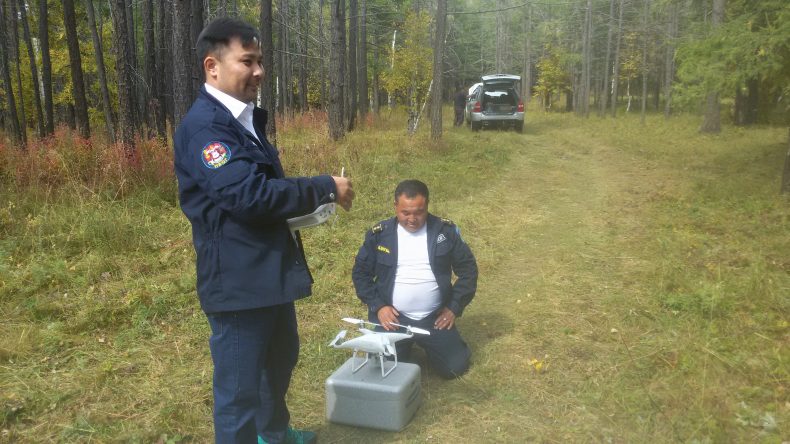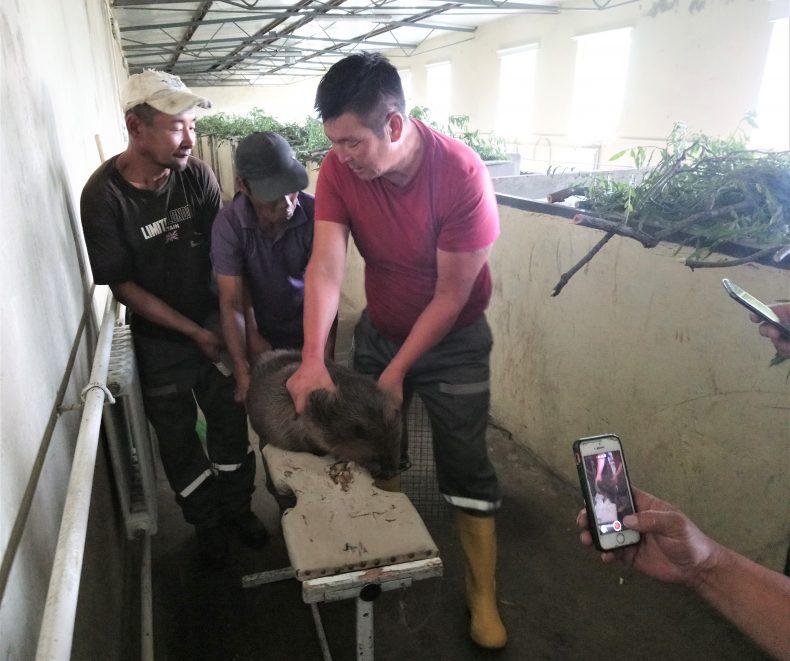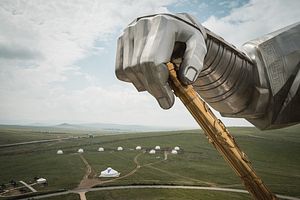We are standing on a mountaintop outside Ulaanbaatar, Mongolia. It’s part of the Khan Khentii mountain range and rests above an aquifer and watershed providing water to the city where about 1.4 million people — half the country’s population — live.
Mr. Chingel prepares a drone using a handheld control unit. The drone rises straight up, hovers a moment above us, then speeds off over the trees. This is a conservation drone, used to monitor the area for illegal activity.
Chingel is head of the Ranger Protection Unit at the Ulaanbaatar Environment Department and leads a force of 33 rangers patrolling Ulaanbaatar’s green zone.
There are four of us – Chingel, a ranger named Tsogbaatar, a driver, a Mongolian journalist translating, and me.
Drones, GPS Tracking, and Ranger Safety
The area urban rangers patrol is about 470,000 hectares and nine districts in central and outer “UB,” as locals call Ulaanbaatar. This breaks down to 5,000 to 10,000 hectares each. While smaller than areas national rangers patrol, the population they interact with is much greater.
A week before, I had met Battulga Erkhembayar, director of the Ulaanbaatar Environment Department, who explained why rangers used drones. Given the importance of this ecosystem, increasing rural migration to the city, and concerns about ranger safety, new technology is being implemented. In the past 10 years, three rangers have died while performing their duties, most recently a ranger with young children.
“His name was Ganbayar. He was in his 30s with four or five children. The youngest child is 2 or 3 years old,” Battulga told The Diplomat. “People say he was killed by illegal loggers, but the official police report says it was a motorcycle crash.”
The department decided to introduce changes. Rangers are advised about what to do in risky situations, which includes not confronting people suspected of engaging in illegal activity when alone. Rangers travel in pairs and are encouraged to record incidents using drones, as video can be used as evidence according to Mongolia’s laws. The UB unit has two drones for patrols.
“There were some articles on local news after his death. Most people became aware of how hard the work of rangers is. The family is not interested in publicity about the case, but they are okay with information used to change the working situation for rangers,” added Battulga.
Rangers have a broad scope of work because of the greater population in the area. They must monitor burning coal, hunting, campfires, and illegal mining. Even foraging for wild berries and pine nuts must be regulated.
“A few people cannot harm nature, but 1 million people can cause harm, so we ask them to pay for the license fee – we get assistance from the police department for this,” says Battulga. Studies on the health of the Khan Khenti and Tuul river watershed confirm degradation from overuse.
Battulga says that he survived a serious accident while chasing illegal loggers, which left him with broken bones requiring surgery and metal pins.
The department has now instituted a satellite GPS tracking system, which monitors rangers’ movements. They are able to signal for help using three codes through the tool.
“One code marker indicates that ‘everything is fine,’ another code marker signals ‘SOS,’ while the third code signals ‘fire,’” says Battulga.
Despite the close proximity to UB, the area the rangers work in can be remote. The day we joined them, we drove off-road across fields and up hills, getting stuck once briefly in the mud. There was no phone signal until we drove closer to Gachuurt, a suburb of UB.

Chingel operating a drone while standing next to Tsogbaatar. Photo by Michelle Tolson.
On Patrol
Back on the mountain, Tsogbaatar, one of the rangers we are traveling with, catches the drone as it returns from a patrol. He is responsible for filing cases documenting illegal activity.
Chingel shows us previously recorded drone footage of a herder setting a marmot trap. He sees the drone, abandons the trap, jumps on his motorcycle, and speeds down a hill. The recording was enough to identify and fine him.
Fines vary based on the incident and are measured by units. Individual fines vary. Fines for digging an illegal well for instance, run to about 300,000 tugriks ($112), while for companies this is about 1.5 million tugriks ($557).
“Traps are illegal,” Chingel explains. Marmots are ideally relocated through cruelty-free traps and taken to open spaces far from people. This gentle management style comes across in other ways.
While the rangers continue their patrol, we encounter a family surrounding a tree, shaking and striking it. Concerned, they stop the vehicle by the family, who look unsure, but after some friendly conversation, shared back and forth, they relax.
“They are gathering berries,” explains my translator. “The rangers are telling them to be careful to not harm the tree.” Foraging is possible, depending on the season and permits are relatively inexpensive. Our vehicle moves on.
The Watershed and the City
The rangers are employing a natural method to help restore the watershed – beavers. Reintroduction projects have gained popularity as beaver dams improve watersheds and help restore the natural ecosystem.
We visit the Beaver Education Center outside Gachuurt, UB’s rural suburb, where about 48 Eurasian beavers live and breed in pairs. They were brought from Russia and Germany in 2012 to help restore the Tuul river watershed.
Mongolia is famous for its snow leopards, eagles, and the Takhi wild horse, but there seems to be little known about its population of 300 rare, indigenous beavers (Castor fiber birulai), a subspecies of the European beaver living in the Bulgan river in western Mongolia. Given their endangered status, the project is introducing Eurasian beavers. About nine babies were born in 2019, with 80-100 born since 2012. The beavers are released into the area after they are old enough as part of the introduction project.
When asked about the success of the project, Chingel says “currently there is no work being done to track beavers [after they are released], as there is no budget for that. Rangers observe beaver activity, such as felled trees, but don’t see beavers.”

At the Beaver Center, a beaver fights the caretaker conducting a health check on him. Photo by Badrakh Byambadorj.
Beavers have been released in the Khan Khentii protected area, adjacent to the area the beavers are raised in. “This protection area extends far east — the urban ranger jurisdiction ends at some areas that belong to other rangers,” Chingel explains.
But Michael Pollock, a watershed and beaver expert, thinks monitoring is less important than educating the community about their importance to the ecosystem.
Pollock traveled to western Mongolia to research a failed reintroduction project and did not see a single beaver, but met a local who recalled hunting the flat-tailed creatures, saying they “had much better fur than muskrats.”
“Getting the local population to understand and cherish the species and take ownership and protection of it, is in my mind going to have to be essential to get them back on the landscape,” Pollock explained by email.
The center is just 35 kilometers from UB but requires a four-wheel vehicle to access as the road crosses a rocky, muddy riverbed. It’s marked by what3words, a GPS tracking app that helps people find remote locations. The center is intended to help locals learn about beavers. It is looks somewhat like a wet dog kennel, but is quiet, except for soft music playing from the windowsill.
“Beavers like music,” explains a red-shirted caretaker, T. Ganzorig. He checks the beaver families and feeds them leafy branches. Carrots are also popular with the beavers.
But Pollock mentions beaver food as another concern. “Mongolia is open to grazing, so the rivers often have very little willow or other species that the beaver need to eat. Getting [herders] to keep their flocks away from streams is going to be really difficult, but again, some sort of educational program will help… Basically, something that would keep [away] overgrazing of the riparian vegetation would be very helpful.”
But Chingel is confident in the community’s knowledge of the beavers. When told about Pollock’s experience in western Mongolia, Chingel says that “maybe the man [Pollock spoke with] confused them with marmots. Or maybe he was joking.”
Rural Rangers, Motorcycles, and Skis
Mongolia has another important watershed. Lake Hovsgol national park witnessed a massive jump in tourists after a road rehabilitation project — going from 7,000 visitors annually in 2004 to over 45,000 in 2014. The lake holds 70 percent of Mongolia’s freshwater and is the headwaters to Lake Baikal.
Former U.S. National Park Ranger Bob McIntosh volunteered at the park during that time and saw rangers struggling to protect the park because their motorcycles broke down during patrols. He co-founded Rally for Rangers, which brought quality Yamaha AG 200 bikes. Since 2015, the initiative has delivered bikes to six protected areas — Lake Hovsgol, Horidal Saridag, Tengis-Shishged, Ulaan Taiga, Otgontenger Altai Tavan Bogd, Munkh-Khairkhan, and Khar Us Lake.
“These are helping rangers expand their patrol areas and decrease their time of travel. Their presence and quick response time are the first line of defense against poaching, looting of cultural sites, and illegal mining and timber harvest,” McIntosh told The Diplomat by email.
National rangers have had violence directed against them for their work. “In the last few years individuals have retaliated against enforcement against illegal mining in Ulaan Tiaga and Tengis- Shishged protected areas,” McIntosh added. “In both cases, they burned the ranger station. At Tengis-Shishged they also burned the two Rally motorcycles that had been stored there.”
However, McIntosh says “to my knowledge, violence against Mongolian rangers is very low.”
Jal Tumursukh, a prominent lead ranger in Darhad, has also worked with Rally for Rangers to bring equipment to his rangers. Tumursukh lost his son, Sumbe Tumursukh, also a conservationist, to violence in 2015. Sumbe had dedicated his time to a mountainous region in the Gobi Desert to protect a population of endangered snow leopards. He was attacked at knifepoint twice, finally drowning mysteriously in Lake Hovsgol. The parents told The Diplomat in 2015 that they believe Sumbe was murdered by illegal miners for his work. Undaunted, Tumursukh continues to work closely with international conservationists to bring much needed equipment to his rangers.
But deep winter snows hamper access for rangers working in three protected areas around Darhad. Rebecca Watters, executive director of the Wolverine Foundation, travels seasonally to Mongolia to study wolverines in the remote Darhad region, also working with Jal Tumursukh. She and another researcher saw rangers’ lack of equipment during the winter season and decided to raise funds for ranger skis.
“Rangers spend 10 or 20 days at a time away from their families, trying to prevent illegal gold mining and poaching for the wildlife parts market,” Watters explained by WhatsApp from her research camp.
Skis help rangers access areas with deep snow that horses can’t get through –“including the areas most attractive to miners. [Skiing] is a low-tech, environmentally friendly way to reach snowbound locations.”

Group photo of several rangers, including Ts. Togbaatar, B. Sanjmyatau, X. Byambaa, A. Ulziitogtolch, Ya. Byambajau, D. Natsydorj. Photo by Badrakh Byambadorj.
Mission-Driven Rangers
Rangers seem to be a mission-driven type of people, given the incredible challenges they face.
National park rangers “are responsible for 70-120,000 hectares each, depending on the region they work. The government pays them less than $10 a month for gasoline and fodder for horses,” explains Badral Yondon, co-chair of the board at the Mongol Ecology Center, a national organization working with Rally for Rangers.
Rangers’ earnings are low as well, making just 500,000 tugriks ($185) a month, according to Chingel. While a stipend is paid to a family when a ranger dies, the amount is low. With so much risk, limited resources, and so little pay, one might wonder why people become rangers at all
Chingel, with nine years of experience, believes there are different types of people drawn to the profession. “Some go alone, it is a passion for them. About 60-80 percent of the families live in the area under protection – they are already involved. While about 30-40 percent of the families and rangers used to work in law enforcement – it is a part of their life.”
Tsogbaatar, who manages the Khan Khentii area and has 10 years of experience, has a practical explanation. “It’s part of my job to be there no matter what – day, night, bad weather, winter. This whole idea of protecting nature, this part of the mountain is our legacy and [our] children’s legacy for the future.”
We continued our patrols that day. In the tradition of warm Mongolian hospitality, the day included snacks of aruul dried cheese curd, urum cream on bread, and hot brewed tea. With the easy laughs and camaraderie, the rangers’ interaction with each other feels like family. Perhaps this another reason.
Translations by Badrakh Byambadorj.
Michelle Tolson is a freelance journalist based in Asia.

































